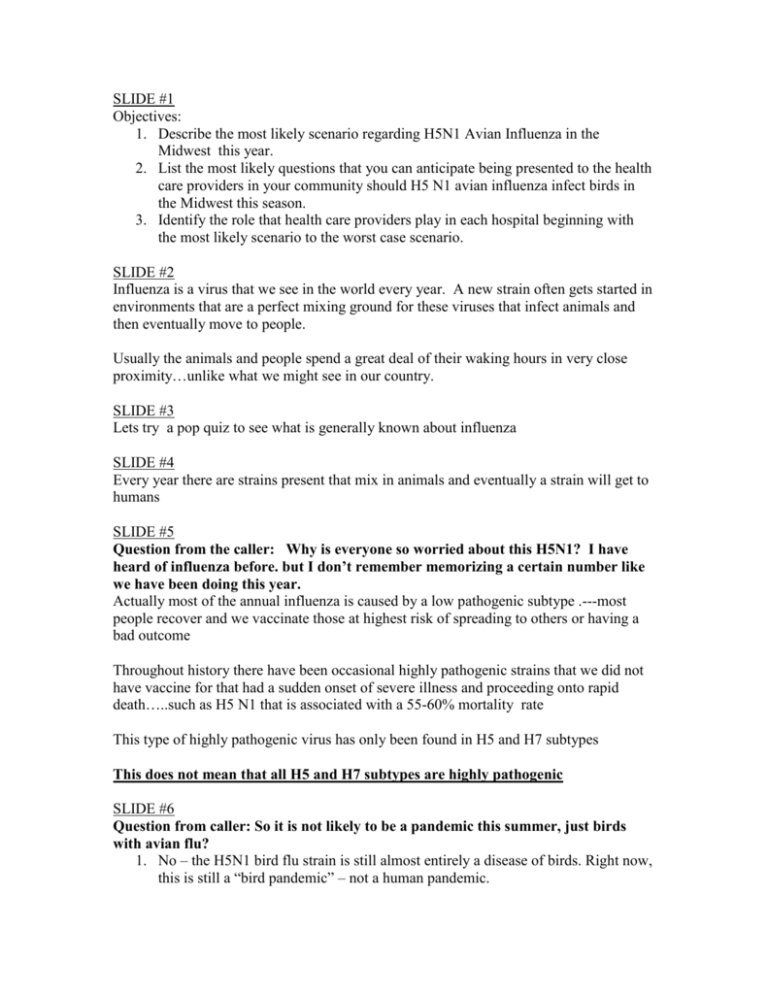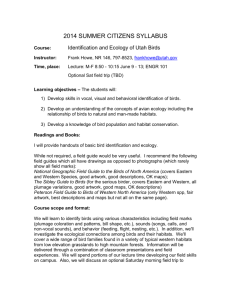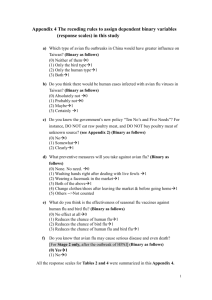Notes
advertisement

SLIDE #1 Objectives: 1. Describe the most likely scenario regarding H5N1 Avian Influenza in the Midwest this year. 2. List the most likely questions that you can anticipate being presented to the health care providers in your community should H5 N1 avian influenza infect birds in the Midwest this season. 3. Identify the role that health care providers play in each hospital beginning with the most likely scenario to the worst case scenario. SLIDE #2 Influenza is a virus that we see in the world every year. A new strain often gets started in environments that are a perfect mixing ground for these viruses that infect animals and then eventually move to people. Usually the animals and people spend a great deal of their waking hours in very close proximity…unlike what we might see in our country. SLIDE #3 Lets try a pop quiz to see what is generally known about influenza SLIDE #4 Every year there are strains present that mix in animals and eventually a strain will get to humans SLIDE #5 Question from the caller: Why is everyone so worried about this H5N1? I have heard of influenza before. but I don’t remember memorizing a certain number like we have been doing this year. Actually most of the annual influenza is caused by a low pathogenic subtype .---most people recover and we vaccinate those at highest risk of spreading to others or having a bad outcome Throughout history there have been occasional highly pathogenic strains that we did not have vaccine for that had a sudden onset of severe illness and proceeding onto rapid death…..such as H5 N1 that is associated with a 55-60% mortality rate This type of highly pathogenic virus has only been found in H5 and H7 subtypes This does not mean that all H5 and H7 subtypes are highly pathogenic SLIDE #6 Question from caller: So it is not likely to be a pandemic this summer, just birds with avian flu? 1. No – the H5N1 bird flu strain is still almost entirely a disease of birds. Right now, this is still a “bird pandemic” – not a human pandemic. 2. In rare cases, the H5N1 virus has caused human illness – but for the most part, only in people who have had extensive, close contact with infected domestic poultry or their droppings. 3. No one has been infected through contact with wild birds 4. Person-to-person spread of H5N1 has been extremely rare 5. Unless the H5N1 bird flu virus changes dramatically, so it can pass easily from person to person, we are unlikely to see widespread human disease. SLIDE #7 1. Public health officials remain concerned about the possibility of a future pandemic. We need to be prepared for that possibility. 2. Three worldwide pandemics occurred in the last century – and scientists believe that another pandemic will occur some day. Question from Caller: So right now –we are not sure what may happen except some birds will probably get avian flu? 1. If the H5N1 bird flu strain changes, so it can pass easily from person to person, it could cause a pandemic. That may or may not ever happen. 2. A pandemic could be also be caused by a completely different flu virus – one that we haven’t seen yet. 3. Public health officials at all levels of government are watching closely for changes in the H5N1 bird flu virus – and any other potential pandemic threats. 1. Surveillance for H5N1 bird flu is already underway on major bird migration routes leading into the U.S. 2. In the coming weeks, the U.S. Geological Survey and the U.S. Fish and Wildlife Service will be working with state officials – primarily in Alaska – to test thousands of wild birds. 3. Initially, Minnesota will not be directly involved in the federal testing effort. However, the Minnesota Department of Natural Resources will be supporting these efforts, and will be preparing a plan for wild bird surveillance in Minnesota. SLIDE #8 Question from caller…what is being done in MN? 1. Anticipated surveillance efforts in Minnesota include investigation of waterfowl die-offs, and sampling of birds in connection with bird-banding and hunter bagchecks. 2. The University of Minnesota and others will be doing some limited testing of birds, and DNR will also be assisting with those efforts. 3. There are many strains of bird flu besides the “H5N1” strain – and it’s not uncommon to find them in wild birds. None of them are known to pose a threat to human health. 4. Other bird flu strains are around all the time. We have experience looking for them and responding to them. SLIDE #9 Question from caller: Can you explain exactly how I know that Minnesota is on top of this situation? I am a little nervous? 1. “Avian influenza” includes a whole family of viruses. It’s been around for a long time. Every year, we have garden-variety forms of avian flu, and this year is no different. 2. We have a monitoring system in place to help us quickly identify commercial poultry flocks infected with avian influenza, contain the infection and work with the industry to eliminate it. 3. The forms of bird flu we’ve seen have not been “highly-pathogenic” strains like H5N1. 4. In fact, Minnesota’s poultry industry has never had a case of the more serious “high-pathogenic” form of avian flu in nearly 30 years of surveillance. 5. Modern poultry production practices effectively shield poultry from contact with wild birds. That makes spread of these diseases less likely here than in other parts of the world. SLIDE #10 1. When poultry producers see disease warning signs in their flocks, they contact their veterinarian. If the veterinarian suspects a form of avian influenza, he or she is required to contact the Minnesota Board of Animal Health. 2. Minnesota was among the first states to work with turkey growers to establish a voluntary monitoring network, beginning in 1986. 3. The Board of Animal Health is creating a similar monitoring network for the state’s commercial egg and broiler producers. 4. A turkey processing plant surveillance program was created several years ago to identify infected flocks. 5. BAH is working with small backyard flocks to diagnose, control and prevent influenza using biosecurity, sanitation and disease control measures. 6. The state is working to bring veterinarians, poultry producers and others up to speed about the warning signs of highly pathogenic H5N1 avian influenza. SLIDE #11 1. Commercial poultry is monitored carefully for illness – including different strains of bird flu – by state and federal authorities. 2. In Minnesota, chickens and turkeys are monitored for disease by the state Department of Agriculture and the Board of Animal Health. Question from caller: And what if something is found in poultry? 1. Even if the H5N1 bird flu virus were present in poultry, it is extremely unlikely that you would ever be infected by handling, cooking or consuming it. 2. Normal precautions for handling and cooking poultry should make it safe to prepare and eat. These precautions include a. Cleaning all utensils and food preparation services thoroughly after working with raw poultry. b. Washing your hands thoroughly after handling raw poultry. c. Cooking poultry thoroughly – to an internal temperature of 165 degrees or higher – before eating it. d. You should be following these precautions anyway, to prevent routine food-related diseases like salmonella. SLIDE #12 1. Wild birds can carry the H5N1 bird flu virus, but it usually doesn’t make them sick. If you find a dead bird, it’s unlikely that it died from H5N1 bird flu. 2. If you find a dead bird, simply put it in a plastic bag and put it in the garbage – and then wash your hands thoroughly. Question from caller; MDH does not want any dead birds? 1. Neither the Minnesota Department of Health nor the Minnesota Department of Natural Resources has plans to test wild birds for H5N1 bird flu or accept dead birds for testing. 2. You may remember that MDH tested dead birds for West Nile Virus as a way to track the presence of the virus in mosquitoes. That isn’t an issue with H5N1 bird flu. SLIDE #13 1. To date, there have been no reported cases where people have gotten H5N1 bird flu from wild birds. 2. In general, people should try to avoid contact with wild birds or their droppings – not necessarily because of bird flu, but as a general health precaution. Question from caller: But sometimes I like to go biking and I may get bird droppings on me. 1. If you can’t avoid contact with wild birds or their droppings, wash your hands, and avoid bringing feces into your home on shoes or clothing. 2. Clean your shoes or clothing as necessary. A bleach solution and exposure to sunlight may be helpful for disinfecting shoes. SLIDE #14 1. To date, there have been no reported cases where people have gotten H5N1 bird flu from wild birds. 2. Regardless of any potential threat from H5N1 bird flu, routine precautions should always be followed when handling or cooking wild game: a. Do not eat or handle any game birds that appear to be sick. b. Wear rubber or disposable latex gloves when handling or cleaning game birds. c. After handling game, thoroughly wash your hands, as well any knives, equipment or surfaces that came in contact with game. d. Do not eat, drink, smoke, or rub your eyes or mouth while handling game. e. Thoroughly cook all game to an internal temperature of 165 degrees or higher. Question from caller: Where can I get more information? You can get all of the information that you need on the MDH web site. http://www.health.state.mn.us/ SLIDE #15 1. Even if the H5N1 bird flu virus were present in poultry, it is extremely unlikely that you would ever be infected by handling, cooking or consuming it. Question from Caller: You know this bird flu could affect my business. What is being done to monitor the illness? 1. In Minnesota, chickens and turkeys are monitored for disease by the state Department of Agriculture and the Board of Animal Health. Question from the caller: are there special precautions I should tell my staff when preparing chicken? 1. Normal precautions for handling and cooking poultry should make it safe to prepare and eat. These precautions include a. Cleaning all utensils and food preparation services thoroughly after working with raw poultry. b. Washing your hands thoroughly after handling raw poultry. c. Cooking poultry thoroughly – to an internal temperature of 165 degrees or higher – before eating it. Question from the caller: Well I should be doing that anyway, shouldn’t I? You should be following these precautions anyway, to prevent routine food-related diseases like salmonella. SLIDE #16 1. There are no known cases in which people have gotten H5N1 bird flu from eating eggs. 2. Proper cooking kills bacteria or viruses that may be present in eggs. 3. Eggs should be cooked thoroughly – so the yolks are not runny or liquid. SLIDE #17 Question from caller: Some of my family like to eat eggs sunny side up—can I prepare them this way? 1. The best way for consumers to protect themselves and their families is by thoroughly cooking meat and poultry products, including eggs. 2. Eggs prepared “sunny-side up” are typically not heated to a temperature that kills potentially dangerous bacteria like salmonella, or viruses like avian flu. 3. Eggs intended for human consumption are typically washed and sanitized before being sold, so any virus on the shell would be inactivated. SLIDE #18 If you own birds, a few simple precautions can help you reduce any potential risk to your birds – or to your own health. 1. Monitor your birds daily for any signs of disease. In birds, flu causes swelling around the head and discharge from the eyes, nose and mouth. The H5N1 strain causes severe illness and death in chickens and turkeys. 2. Keep wild birds – especially waterfowl – away from your domestic birds. Avoid exposing your birds to feed, water or bedding that may have been contaminated by wild birds. 3. Avoid exposing your birds to sick birds. If your birds become severely ill – or die – consult a veterinarian promptly. 4. Wash your hands thoroughly after working with your birds to minimize your any potential exposure to bird flu. If you have questions about safe handling of your birds, go to the U.S Department of Agriculture website at http://www.aphis.usda.gov/vs/birdbiosecurity or call 1–866–536– 7593. SLIDE #19 1. To date, there have been no reported cases where people have gotten H5N1 bird flu from wild birds. 2. Bird flu is primarily a disease of waterfowl and shorebirds, and is not typically seen in the “back yard” bird species that visit bird feeders. Question from caller: Jumping catfish, that is a relief 1. Because wild birds can also carry other diseases – such as salmonella – a number of precautions are recommended for people who keep bird feeders: a. Wear rubber or disposal latex gloves while cleaning bird feeders or bird baths. b. Use a plastic bag to pick up any dead birds, and dispose of them in the garbage. c. Do not eat, drink, smoke, or rub your eyes or mouth after handling birds, until you can thoroughly wash your hands. SLIDE #20 1. The risk of being infected by swimming in the same water with infected waterfowl is extremely remote. 2. There is no evidence that anyone has ever been infected in this way. Question from caller: I don’t know how to swim and usually stay near the shore. That should be okay, shouldn’t it? 1. As a general health precaution, bathers may want to avoid shallow areas were waterfowl may be present – and especially avoid swallowing any water SLIDE #21 1. There are no known cases where people have gotten H5N1 bird flu from animals other than chickens. 2. A few cases of H5N1 bird flu have been reported in large cats or domestic cats, in Europe and Asia. In all cases, these animals were infected by eating raw, infected poultry. 3. Regardless of any potential risk from H5N1 bird flu, pet cats should always be kept indoors to minimize possible health risks. Question from caller: But what about pet birds? 1. Pet birds should not be at any risk as long as they have no contact with wild birds. SLIDE #22 • All birds are subject to inspection at the slaughter plant. Birds that do not pass inspection are withheld from the food supply. • The more dangerous forms of avian flu typically kill birds quickly, making it unlikely they would ever even reach the poultry processing facility. • Fortunately, proper cooking destroys avian flu viruses and other potentially harmful disease-causing microbes. There is no danger of getting avian influenza from properly cooked poultry. SLIDE #23 1. Staff will not show up for work if they are occupied with the safety of their family, pets, or livelihood…..It is important for all families to have a Emergency Plan that could be used for any hazard and adjusted for a new threat such as avian influenza in migratory birds 2. Staff in health care agencies will be overwhelmed with phone calls and walk in visits from the worried well…..paralyzing the normal operations 3. Patients may suffer from a delay in important interventions and from errors resulting from exhaustion in the workers who have reported for duty. 4. It is critical for HR to get involved now with your hospital planning to anticipate how these might impact the work force and work with your agency and community resources to anticipate, plan and practice mobilizing for such events. 5. We need to strengthen our infrastructure in every community and practice mobilizing with speed and accuracy for different events in order to be ready for the unforeseen. SLIDE #24 SLIDE #25 SLIDE #26 SLIDE #27 SLIDE #28





